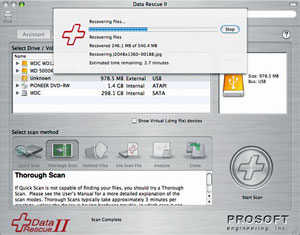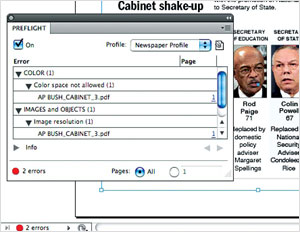|
Main Stories
“Let’s stick with incredible”
Excuse me, but I have to sit down. It’s time to let you know about a few of the new features in Adobe Creative Suite 4. And after taking a fresh look at these applications, I need to catch my breath because some of the features are incredible. No, make that unimaginable. No, let’s stick with incredible. Wow.
Think you’ll never use Soundbooth? Think again. I can’t believe how much better the audio sounds on my recordings. No idea what Fireworks and Flash do? It’s time to learn, my friend. For today, however, I’m going to discuss two features of an application you’re probably already using: InDesign. The feature that most impresses me in the latest rendition of InDesign is the Preflight. I know, I know: InDesign has always had a great preflight function; however, the gang at Adobe has taken it up a notch or two or three thousand. Two things stand out about CS4 preflighting. The first is the ability to create your own preflights that look for just about any potential printing problem. Like previous versions of InDesign, users can search out RGB in images, missing links and more. Now users can select from dozens of potential problems for InDesign to detect before a file goes to print or is converted to PDF. My favourite preflight criteria is the ability to find OPI links in images. You may not know the difference between OPI and LZW, but InDesign knows and will share its knowledge with you before you have a printing issue. Something else that you will love about InDesign’s new preflight: it provides a continuous preflight as you work. That’s right. There’s a little green light in the bottom corner of InDesign’s desktop. If that light turns red, watch it. That means you’ve hit a snag. Man, I could have used that ten years ago.
Next, I created three InDesign documents that each contained some of these issues. Guess what? Yes, InDesign caught them all. Every single error, every CID font, every photo with RGB, and PDFs with OPI information! As we’re forced to do from time to time in the South, I had to sit and have a cool drink before looking any further. Not to worry. You’re going to love what I found next. You’ve seen them: those cool magazines and newspapers on websites that allow you to grab the corner and turn the page. That’s right. You can create a Flash (swf) file that contains everything you need to convert your newspaper to a web publication in InDesign CS4. I am not lying. I’ve done it myself. Soon after discovering this incredible treasure, I received a request for advice from an advertising group in New York. The question: should they purchase a system that would create Flash documents like this of their magazines and other periodicals? I quickly opened a 30-page outline that I give to classes and exported it as a Flash file from InDesign CS4, then uploaded the file to a website so they could see it. I received an e-mail a few minutes later: “We just ordered InDesign CS4.” Enough said. Data Rescue II
After sending the card to an outfit that specializes in getting data from corrupted drives, he learned that the cost for this service was a mere $700. He e-mailed to ask if there was a less expensive way to get the photos off the card. A few days later, FedEx arrived with his corrupt card. Sure enough, when I put it in the slot in my iMac I was informed that the drive was bad and my only option was to format or eject the drive. Not so fast. I remembered that I’d recently received the latest version of Data Rescue II, from ProSoft Engineering. DRII promises to rescue data from dead drives. I figured, “What the heck!” After installing the software, I slipped Gary’s card into my card slot. Next, I instructed DRII to scan the card. Sure enough, hundreds of jpeg file names appeared in a list. I selected “Recover Files” and, sure enough, those jpeg files were copied to a folder I had created on my desktop. A few minutes later I was burning the photos to a CD and filling out a FedEx form. Gary was pleased. (Kevin Slimp is director of the Institute of Newspaper Technology and technology guru. Read past columns at www.kevinslimp.com. Newspapers can sign up to spend an hour with Kevin during live webinars at www.braincast.biz) nnn
|
 Kevin Slimp
Kevin Slimp Data Rescue II scans corrupted disks and retrieves files that were “destroyed” by
the bad disk. DRII is available at prosofteng.com.
Data Rescue II scans corrupted disks and retrieves files that were “destroyed” by
the bad disk. DRII is available at prosofteng.com. InDesign CS4 includes an incredible preflight feature that checks for problems on pages
as you create them. This InDesign page had two errors, both found in a PDF file.
InDesign CS4 includes an incredible preflight feature that checks for problems on pages
as you create them. This InDesign page had two errors, both found in a PDF file.